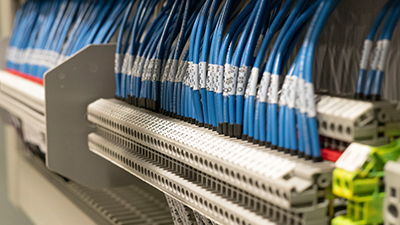Kevin Tilton, controls engineer at Ahaus, has been with the company since 1992. Tilton performs an extremely important function of our machine building process: he designs the electrical interfaces and mechanical controls that human operators use to control the machines.
At the start of a new project, Tilton’s first goal is to review the customer’s specifications and lead the mechanical engineers in the right direction in terms of which type of components to select for the machine. That includes advising on the necessary voltage, electrical systems components, and anything regarding the machine’s controls. Once the mechanical engineers are done with their design, they provide Tilton with a list of the switches, motors, cylinders and all the actions needed on the machine. He takes that information, as well as the customer’s original specifications, and creates advanced electrical drawings, complete with the cabinet layout.
Tilton’s next step is to write the programming for the machine’s electric controls. For more advanced automation equipment, this often involves creating an HMI (Human Machine Interface). Once programming is complete and installed on the machine, Tilton debugs it and ensures that it’s operating correctly and efficiently, and makes any corrections or necessary updates to the machinery. The machine is then ready to ship. If the customer requests installation services, Tilton or one of Ahaus’ other controls engineers will accompany the machine builder or an Ahaus service operator to install the machine and help the customer understand the operations and controls.
Another term for “controls engineering” is “electrical engineering.” In some industries, and especially at universities, electrical engineering is a varied term. As an OEM (original equipment manufacturer), an electrical engineer at Ahaus is someone who designs, programs, debugs, and applies electrical controls systems to automatic and semi-automatic assembly machines and test equipment.
Most of the machines Ahaus builds are semi-automatic, which means a human operator is necessary to operate the machine, usually to load it and initialize cycles. Some machines we build are what Tilton calls “automatic” — while a human operator is still present to feed and monitor the machine, the machine cycles are entirely automated and continuous. There are different challenges for a controls engineer, depending on the level of automation in the machine.
“Human interaction presents many variables in machine design; the skill level of the operator is one variable, for example, that can completely change the controls of a machine,” said Tilton. “My job is to work with the customer to fully understand their needs, and how to best implement their requirements and expectations.”


